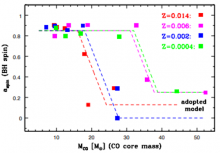
Abstract
The Advanced Laser Interferometer Gravitational-wave Observatory (LIGO) and Advanced Virgo have observed five binary black hole mergers thus far. The effective spin of of one of them, GW170104, has an 82% probability of being negative, which would indicate significant spin-orbit misalignment and seemingly supporting dynamical formation over classical isolated binary evolution. Massive stars can have efficient inner transport of angular momentum and their strong winds carry away substantial angular momentum, affecting the natal spin of the black holes created at the end of their lives. We present a physically motivated model for black hole natal spins with massive stellar-origin black holes (M_BH > 30 Msun) forming with low spin. This model is incorporated into our population synthesis with which we follow across cosmic time the classical isolated binary evolution of Population I/II stars predicting the binary black hole population in the Universe. Our model produces a binary black hole population that is consistent with the observed LIGO/Virgo population. In particular, it produces systems that are in agreement with the measured properties of GW170104; total mass, mass ratio, effective spin, agreeing at the same time with the overall binary black hole merger rate. Although producing negative effective spin becomes easier with addition of natal kicks in isolated evolution or through dynamical captures in dense globular clusters, neither strong natal black hole kicks nor dynamical interactions are necessary to reproduce the properties of GW170104. However, if the effective spins of black holes observed by LIGO/Virgo continue to be very small (X_eff ~ 0), it will indicate that our model overestimates natal spins for black holes with modest mass (M_BH < 30 Msun) and that there is efficient core-envelope rotational coupling in stars that form these black holes.